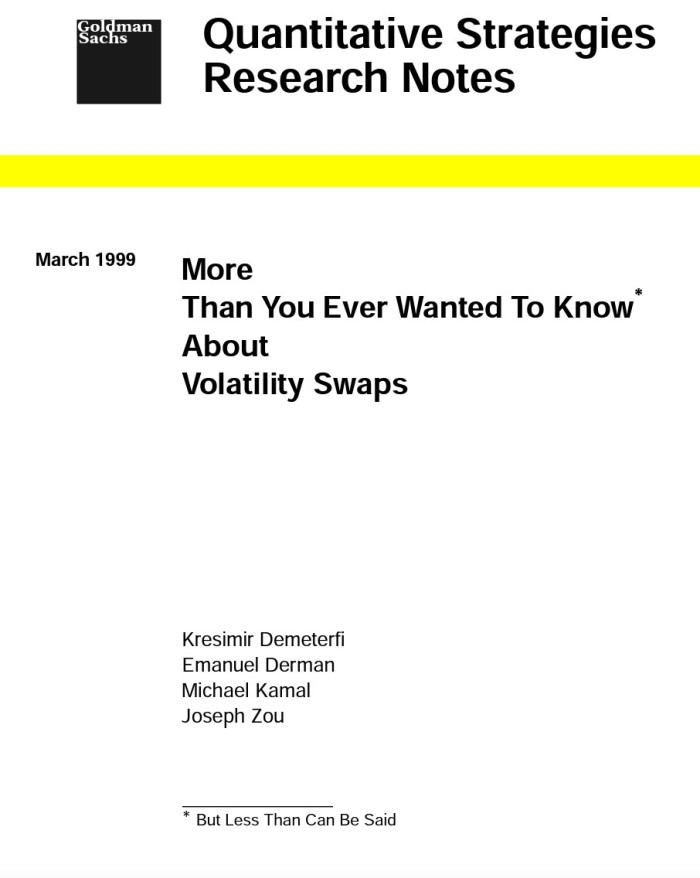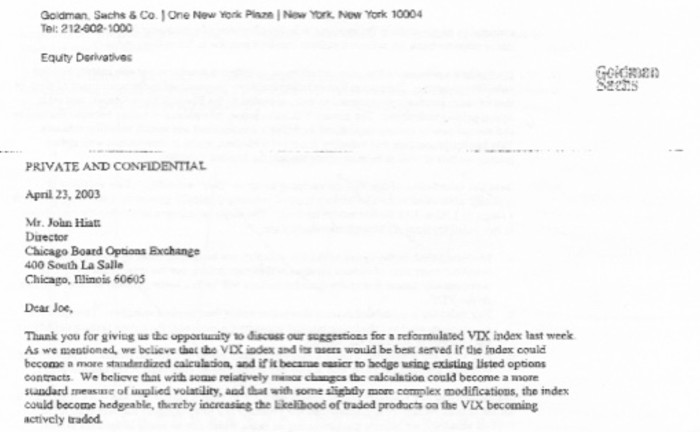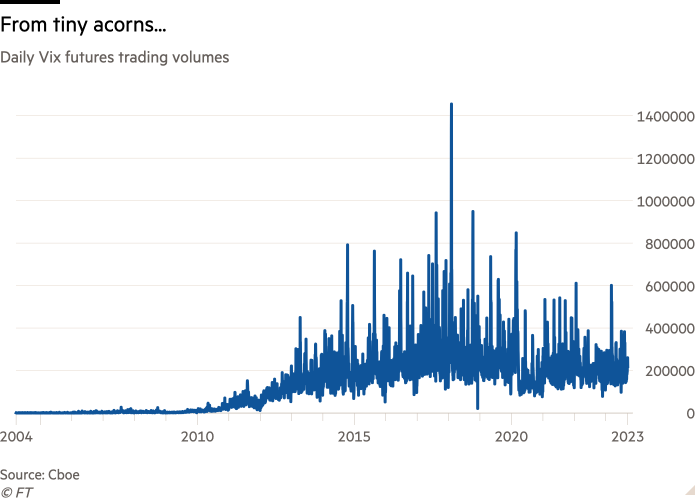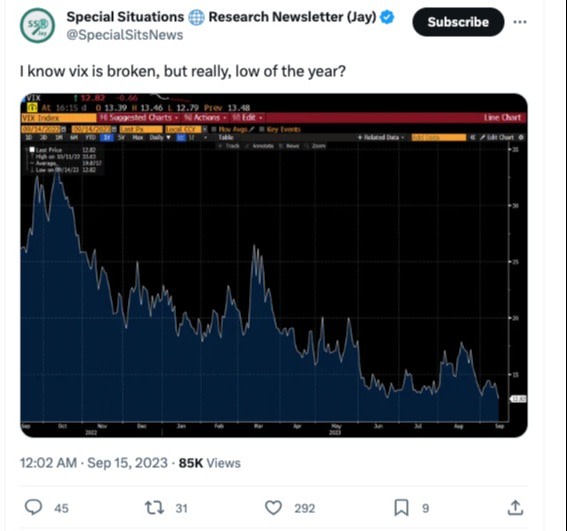An oral history of the fear index

Roula Khalaf, Editor of the FT, selects her favourite stories in this weekly newsletter.
The Cboe Volatility Index — commonly known as Vix because of its ticker — turned 30-years-old earlier this year. But an arguably more important if less appreciated marker took place two decades ago today.
In January 1993, the Chicago Board Options Exchange first unveiled the gauge of expected stock market volatility as implied by options prices, based on a formula by professor Bob Whaley, which he developed over a six month vacation in France.
Its first incarnation was pretty rudimentary, however. Although it became semi-famous as “the fear index*”, it was only based on S&P 100 options. Calculation quirks made it unstable. And most of all, you couldn’t actually trade it. It was just a number and a line on a screen.
The Vix in its current incarnation came into being exactly 20 years ago, when a team of Goldman Sachs and Cboe quants on Sept 20, 2003 unveiled a revamped benchmark based on S&P 500 options, with an improved methodology that allowed the rollout of futures based on the Vix (and today even options).
The lead developers were Devesh Shah, Sandy Rattray and Tim Klassen at Goldman Sachs, and Joe Levin, John Hiatt and Bill Speth from Cboe’s research and product development business.
We spoke with a few of them (Levin sadly passed away in 2020) to find out how it happened. As mainFT mentions in a 2018 magazine piece on the history of volatility, it all started with a 2002 call to Goldman from Mark Cuban, who wanted to “buy the Vix” to protect himself against the unravelling dotcom bubble . . .
Devesh Shah:
He was expecting a significant spike in Vix. The problem was that there was no Vix to trade. The S&P 100 Vix that Bob Whaley had designed was untradable. Almost no one traded S&P 100 options. The Vix was just there, doing basically nothing.
Sandy Rattray:
The formula was such that you couldn’t hedge it. There was no liquidity in S&P 100 options. It was this remarkable thing where everyone knew what it was, they could see levels on a screen, people were starting to trade volatility, but you couldn’t trade the actual volatility index.
As Rattray said, this was a time when trading volatility itself was starting to become A Big Thing — at least for more sophisticated investors. The first “variance swaps” appear to have been structured in the early 1990s. It remained a small business until they were embraced by John Meriwether’s high-octane hedge fund LTCM.
That famously ended badly for LTCM. But when Goldman Sachs dispatched David Rogers to be part of the Wall Street dismemberment of the fund, he returned intrigued by all these vol trades LTCM had put on. He asked Emanuel Derman, Goldman’s chief quant, to figure them out.
So in 1999, Derman published this banger:

Shah:
It was a seminal paper. It got Wall Street thinking about trading volatility for the sake of volatility. Earlier, equity desks on Wall Street didn’t need to trade volatility because we were in the dotcom boom. People were trading so many equity options that banks were making money hand over fist and didn’t need to trade volatility for the sake of volatility. But then the crash came, and everybody needed to figure out other sources of business. Volatility itself became an asset class.
The problem was that variance swaps were hard to industrialise, at a time when most investment firms weren’t exactly stuffed with the requisite expertise.
Rattray:
The term “variance swap” gave 99 per cent of our clients a headache, and 75 per cent of them just didn’t want to do it. It was a pretty niche product. It was only a small number of sophisticated investors that would trade these things. So when we had this [Cuban] inquiry — which was pretty natural [given the Vix’s growing prominence] — we just didn’t have the capability to trade the most known measure of equity volatility in the world.
This is where serendipity entered the picture. Rattray happened to be visiting Goldman’s New York headquarters soon after Cuban’s call, and ended up having a chat with Shah.
Shah:
We were just having a coffee one day and he asked what was on my mind. I mentioned the call from Cuban, but said it was such a complex beast. I needed to create some kind of product that was insensitive to what the spot S&P was, but would move with spot Vix.
Rattray:
The relationship between trading and research wasn’t quite as good as it should have been, but it turned out that Devesh and I got on quite well.
In Europe there was a lot of flow in exotics those days, especially from the French banks. The American banks were behind on all that, and Goldman was definitely behind. We just weren’t as good at it as the SocGens and BNPs. But I remembered a product called the cliquet, which was exactly like what Devesh was talking about.
Cliquets are basically a series of linked, successive at-the-money options. When the first one expires the next one becomes active. It therefore functions as a kind of ongoing bet on volatility. But cliquets were only really traded in Europe, with American nonplussed by them.
Rattray:
It’s a French word. Is it likely to become a mass brand name in the US? Probably not. But it kicked off the idea that we might build something which was purely sensitive to volatility that you could trade.
At Goldman we knew a lot of about variance swaps, given Derman’s paper. So as we talked we thought, well gosh, what if the Vix was the level of a variance swap, and then you could trade a future on it? You could hedge a one-month future by going long the two-month variance swap and short the one-month variance swap. That was the lightbulb moment.
Of course, lightbulb moments matter little without execution. So Rattray called Joe Levin, the Cboe’s avuncular longtime head of product development, to discuss their idea.
Levin was intrigued enough that Shah, Rattray and their Goldman colleague Tim Klassen wrote a letter on April 23, 2003, to the Cboe outlining their overhaul in a bit more detail. You can find the full letter here.

Fortunately for the Goldman team, the Cboe had already been thinking about overhauling the Vix.
When the “fear index” (sorry!) was initially created in 1993, S&P 100 options were the most actively traded on Cboe. A decade later S&P 500 options were ascendant, so the exchange had already started planning a redesign and the launch of linked volatility products. But Shah and Rattray’s plan still had some wrinkles.
John Hiatt:
We were very keen on the conversation on how to make the Vix tradable instrument. But at the time we didn’t have a futures exchange, we only traded options. So we would have to start a futures exchange and list the Vix futures in order to make this happen.
The interest elsewhere inside Goldman and among its competitors was also lukewarm.
Rattray:
I remember going to see a bunch of floor traders and they were all sceptical of this idea. My boss at Goldman made me call 10 of our competitors to see if we could we get them on board with the idea. Ten out of 10 said they had no interest. There was generally quite a lot of scepticism and half-interest around it.
However, a survey of Goldman’s salesforce revealed a lot of theoretical interest in trading the Vix — and enormous revenue projections as a result — so they got to work. The revamped index was unveiled on September 20, 2003, and once Cboe had built a futures exchange from scratch, Vix futures were launched in early 2004.
Initially, it proved a damp squib, belying those rosy Goldman sales forecasts.
Rattray:
Exactly nothing happened. Nothing happened for a long time. It was a sea of lack of interest in this thing. I’d go to the strats team meetings at Goldman and talk about this thing I was so proud of, but after a while I got ashamed of talking about it, as it was so clearly a commercial failure. By then the fixed income people had taken over, and they were a bit rough around the edges. This really wasn’t doing much for my credibility with these guys.
Hiatt:
So few derivatives products that get launched on exchanges are actually successful. So there was never really any internal pressure about the Vix having underperformed [at Cboe]. But when we went out and talked about it with other banks we’d get beat up pretty heavily for the idea. Nobody thought that what we were doing would get anywhere near where it did.
That you could still only trade Vix futures — which would always trade at a different, higher price from the spot Vix index people could see on their screens — was an obvious complication.
Rattray:
I used to call Devesh the most expensive market-maker in the world. People would see the Vix at 13 or 15 and think they want to buy some of that thing. And they’d call Devesh and he’d say they could have it for 20 . . . That you couldn’t buy it as the spot level was troublesome. It didn’t help in the early days.
But they kept at it, with Shah becoming an enormous market-maker in Vix futures in the first few years of the market (the ongoing hedging it led to was a huge headache, even if dominating the nascent market was very profitable for Goldman). The relatively simple approach to the new Vix’s construction gradually helped more investors get involved.
Shah:
It was designed to look very easy and user-friendly to trade. If it goes up one point, you made one point.
Rattray:
The hedging was difficult. The system was difficult. But the client side was not difficult. And I think that was a really important thing. If you’re used to buying futures and you knew what the Vix was and could see it on your monitor, the fact that the formula had changed was totally irrelevant for the vast majority of people.
Then the financial crisis erupted, sending the Vix soaring and supercharging the until-then steady growth of Vix futures trading. In 2006 only about 1,730 Vix futures contracts traded a day on average. By 2009 it was over 4,500 a day – and climbing.
Shah:
It took the Vix going to 88 — a number it had never scaled before, except perhaps outside the 1987 crash — for the world to wake up.
Hiatt:
The moniker of a fear gauge probably helped a lot . . . It was an easy thing to speak of whenever there was a large drawdown in markets. So from a marketing perspective it became an easy product to talk about.
It’s kept growing. In 2023, an average of about 200,000 Vix futures contracts have traded every day, and close to 740,000 options tied the Vix.


Last year Vix futures trading generated almost $120mn for Cboe, equal to roughly 3 per cent of the exchange’s overall $3.9bn revenues in 2022. Vix options revenues are not broken out, but is probably a bit less than that again.
Rattray:
In the early 2000s, everything that flashed across the [financial] TV screen would be tradable. There would be the price of oil, the 10-year Treasury bond, the S&P 500 and the Vix. And it would literally be the only one of the sequence that wasn’t tradable. So in 20-20 hindsight it was obvious to make it tradable.
We thought it was a decent idea and that it would be successful. But it’s been extraordinary. There was clearly an enormous amount of latent demand for something that is really a derivative of a derivative of a derivative.
Of course, not everyone is crazy about this kind of financial engineering. “Democratising volatility trading” is something that sounds cute in an options exchange pit or Goldman Sachs trading floor, but perhaps there are just some things that shouldn’t be democratised?
In February 2018 we saw just how dangerous it can be, when a few small Vix-linked exchange-traded notes went kaboom and helped precipitate a sudden and violent stock market correction — and event quickly dubbed “Vixmageddon”.
Sandy concedes that not every new invention is societally valuable just because there is demand for them (eg disposable vapes), but argues that the resilience of the Vix complex indicates its worth.
Rattray:
If it wasn’t useful it would just die, so it seems to be useful . . . It democratised vol. It moved it from the world of floor-trading specialists into something that was more broadly available. Has it been socially useful every day? I’m sure it hasn’t been. But has it had some benefit? I think so. If you wanted to buy volatility 20 years ago it was a lengthy arduous process, and now it’s not.
Devesh concedes that heavily leveraged Vix-linked ETNs and ETFs are stupid, but argues that people do learn from debacles like February 2018, and they shouldn’t detract from the success of the Vix.
Shah:
It certainly qualifies as the most successful listed derivatives product, other than the option itself. You see a lot of mistakes in how people use it, but people learn. The ecosystem is evolving and figuring out how to use it better every single day.
Rattray points out that the “complicated” label often slapped on any financially-engineered product elides just how complicated more conventional tradable goods actually are.
Take the price of a barrel of oil for example. On a certain level it’s a simple thing, it’s a sticky black liquid you can use to keep warm. But underneath that you have geopolitics, exploration, exploitation and transportation — all sorts of complicated things in a different way. But I’m not sure it’s more complicated.
The most recent criticism of the Vix is that is somehow “broken”, because it didn’t really go up much in last year’s bear market, and/or doesn’t reflect simmering concerns about this year’s rally.

The reality is that the Vix just isn’t a predictor of calm or volatility and doesn’t have a mechanistic inverse relationship to the US stock market. To paraphrase John, it is what it is.
Hiatt:
People take the Vix as the fear gauge and automatically assume that it is going to steady negative relationship with the S&P 500. But if you expect it to behave in a certain way and it doesn’t behave that way, it’s still telling you something about the market.
*Yes, we’re aware that hardly anyone outside the media actually calls it the fear index, or fear gauge etc. But if you got all the way here you hopefully enjoyed the piece anyway.
Further reading:
— How a volatility virus infected Wall Street
Comments